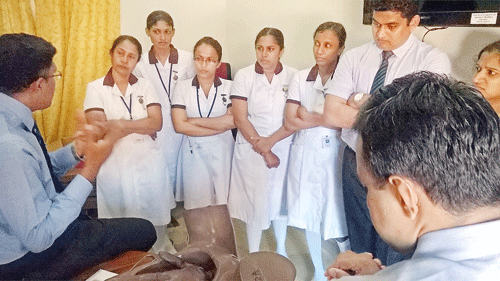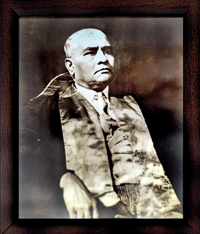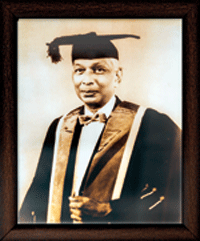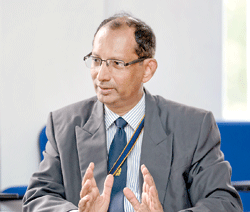A proud record of promoting women’s health

The SLCOG conducting the ‘Safe Motherhood Programme’ for midwives in Kegalle recently. Pic by Sameera Weerasekera
It is the most joyous moment in a woman’s life but it is also fraught with nerves and wracked by pain……..it is not only at this moment of childbirth but also throughout her life that they stand beside her, gently reassuring and supportive.
They guide babies into the world and rejoice with the mothers when they hear those first shrill cries of the newborns, they help sort out issues of adolescence, youth, middle-age and also old-age.
They are the doctors of women – the Obstetricians and Gynaecologists.
As they prepare to hold their three-day 2017 Congress from August 4 to 6, it is a time of special celebration, for the Sri Lanka College of Obstetricians & Gynaecologists (SLCOG) is 50 years old.
Coincidentally, it was a woman Obstetrician and Gynaecologist, Dr. (Mrs.) May Ratnayake, who seems to have acted as a catalyst to bring together the first Ceylon Obstetrics and Gynaecological Association (COGA) back in 1953. COGA’s inaugural meeting, with a committee being elected to “frame” a Constitution, had been held in Dr. Ratnayake’s own home, ‘St. Bryce Dale’ down Ward Place in Cinnamon Gardens on November 19.
Even then, the path of the Obstetricians and Gynaecologists had been crystal clear, with the editorial of the first journal put out in 1954 stating: “The Association of Obstetrics and Gynaecology is not a trade union, nor does it exist for the main purpose of fighting for the rights and privileges of its members. The only fight that figures in our aims is that against maternal and infant mortality.”

Sir Nicholas Attygalle
COGA’s Patron was distinguished Sir Nicholas Attygalle and President Dr. Ratnayake and the association was bent on unifying the practice of gynaecology and obstetrics as one whole, which was separated in Colombo hospitals.
“In contrast to the accepted practice in the rest of the world, in Colombo up to 1954, Obstetricians still continued to practise only midwifery in the two women’s hospitals – De Soysa Maternity Hospital (DMH) and Castle Street Hospital for Women (CSHW). Gynaecology in Colombo was practised at a separate institution viz – The Lady Havelock Hospital (LHH) and also the General Hospital Colombo (GHC). This was subsequently rectified with the closure of the LHH in 1954 and the introduction of gynaecology beds at the DMH and CSHW,” according to a ‘History of the SLCOG’ edited by Dr. Lakshman Fernando.
The life of COGA, believed to be the forerunner of the Association of Obstetrics and Gynaecology of Ceylon (AOGC), had not proceeded beyond 1954 with some speculation that there had been some resentment against the Lady President on a gender basis, states the book.
It had been legendary Prof. D.A. Ranasinghe who had resurrected the idea of forming a new association or society back in January 1967 and with support from colleagues ensured the birth of the AOGC.
A preliminary meeting had been held on August 24, 1967, with a pro tem committee comprising Prof. Ranasinghe, Dr. S. Rajanayagam, Dr. W.S.C. Fernando and Dr. (Mrs.) Siva Chinnathamby getting into action to draw up a Constitution.
The inaugural meeting of the AOGC had followed on December 15, the same year, at the DMH’s Lecture Theatre, the Constitution unanimously adopted and the first office-bearers appointed. The Patron was once again Sir Nicholas Attygalle, the President Prof. Ranasinghe and the Secretary/Treasurer Dr. Chinnathamby.
The initial subscription for members had been Rs. 15 per annum!

Prof. D.A. Ranasinghe
“The year was a busy one with scientific meetings, several guest lectures and social events,” reveals the ‘History of the SLCOG’, with the council meeting four times during the year at the residences of different members.
A highlight, relevant even today 50 years later, was the appointment by the council of a sub-committee to draw up a memorandum to be submitted to the then Health Minister regarding the ‘Reduction of Maternal Deaths in Ceylon’. It would be the first of many on maternal mortality.
The AOGC would use Wijerama House, the home of the Ceylon Medical Association (now the Sri Lanka Medical Association – SLMA) at Wijerama Road, Colombo 7 as its mailing address but later move to its very own home down Model Farm Road in Borella, behind the General Cemetery, Kanatte and adjoining a side gate of the CSHW.
The rest is history……….elevation of AOGC to the status of a college – the Ceylon College of Obstetricians and Gynaecologists (CCOG) in May 1970, the first journal being published in 1970/71 and with the advent of the Republican Constitution to the country, a further name-change to its current Sri Lanka College of Obstetricians and Gynaecologists (SLCOG).
Reiterating that the SLCOG is built on the main foundations of a professional body providing quality obstetric and gynaecological work on a voluntary basis, current President Prof. Deepal S. Weerasekera says that the old principles still hold sway. The SLCOG is not there to win the rights of its members but to promote women’s health and reduce maternal mortality (death) and morbidity (illness) by providing technical support to the Health Ministry and its arm dealing with maternal and child health, the Family Health Bureau (FHB).
The SLCOG has a membership of around 280, while all Teaching Hospitals, Provincial General Hospitals, District General Hospitals and Base Hospitals have Consultant Obstetricians and Gynaecologists.
“Our efforts to bring down the maternal mortality rate (MMR) have been successful,” he says, pointing out that Sri Lanka’s MMR at 33 deaths to 100,000 births, is the lowest in Southeast Asia.
Comparing the MMR to when the SLCOG was born 50 years ago — around 100 to 100,000 births – and now, Prof. Weerasekera says that though there has been a “steep drop” over the years, they are not ready to rest on their laurels but are striving to do more. “There is a long way to go and the goal is to cut the MMR to below 10 per 100,000 births as in the developed world.”

Prof. Deepal S. Weerasekera
There are strong systems in place, it is learnt. Every maternal death, anywhere in the country, has to be notified within 24 hours, with an institutional (hospital) inquiry following promptly in its wake. Thereafter, annually comes a Maternal Mortality Review at district level with the health authorities as well as the FHB and the SLCOG participating.
“These are fact-finding and not fault-finding missions,” he says, adding that this is all part of the ‘Safe Childbirth Programme’ where they look into the reasons why the death occurred and take whatever preventive action is necessary.
Under the ‘Safe Motherhood Programme’, the SLCOG also goes to all the regions and conducts workshops and lectures to uplift the skills and knowledge of field midwives and other healthcare personnel in this arena such as field nurses and also Medical Officers of Health (MOHs) scattered across the country. The college engages the regional and provincial health authorities in all these activities as the logistical support is extended by them.
The ‘Safe Motherhood Programme’ had been initiated by the SLCOG in the early 1990s.
The SLCOG, meanwhile, is also very much a part of the Post-graduate Institute of Medicine (PGIM) providing in-depth knowledge on the latest operating methods, advances and management of pregnancies and childbirth to trainees.
This is while the SLCOG provides know-how on normal, forcep, vacuum and Caesarian deliveries under the Programme ‘Essential Obstetric Care’ conducted in its Simulation Centre to a large number of ‘ordinary’ doctors who are carrying out these tasks as Senior House Officers (SHOs) in maternity units in hospitals across the country. It also conducts lectures, by both local and foreign speakers under its Professional Development and Capacity Building Programme.
| Eminent gathering at Golden Jubilee Congress this week | |
| The Golden Jubilee Congress 2017 of the Sri Lanka College of Obstetricians & Gynaecologists on the theme ‘Women’s Health: Past Experiences, Future Agenda’ will be held from August 3-6, at the Bandaranaike Memorial International Conference Hall (BMICH) in Colombo amidst a distinguished gathering.The Chief Guest at the inauguration on Thursday will be President Maithripala Sirisena, with Health Minister Dr. Rajitha Senaratne also participating. A commemorative stamp is to be issued the same day, while today will be the SLCOG’s Golden Jubilee Walk.Three respected international associations that will be collaborating with the SLCOG, headed by Prof. Deepal S. Weerasekera. They are the International Federation of Gynaecology and Obstetrics (FIGO) led by its President, Prof. C. N. Purandare; the Asia and Oceania Federation of Obstetrics and Gynaecology (AOFOG) led by its President, Dr. Ravi Chandran; and the South Asian Federation of Obstetrics and Gynaecology (SAFOG) led by its President, Prof. Rubina Sohail. For the first time in the history of the SLCOG, a delegation from the largest college in the world, the American College of Obstetricians and Gynaecologists (ACOG) with a membership of a huge 58,000 headed by Dr. Haywood Brown will be attending the congress, it is learnt. Other delegations from national colleges scheduled to take part include those from the Royal College of Obstetricians and Gynaecologists (RCOG) led by its President Prof. Lesley Regan; the Royal Australian and New Zealand College of Obstetricians and Gynaecologists (RANZCOG) led by its Vice President Dr. Vijay Roach; the Federation of Obstetrics & Gynaecological Societies of India (FOGSI) led by its President Dr. Rishma Dhillon Pai; and the Japan Society of Obstetrics and Gynaecology (JSOG) led by its President Prof. Tomoyuki Fujii. The highlights of the congress will be the Keynote Address on ‘Second stage of labour: Potential consequences on mother and infant’ to be delivered by FIGO President Prof. Purandare; the D.A. Ranasinghe Oration on ‘Towards SDG (Sustainable Development Goal) 5 — achieving gender equality by 2030’ by RCOG President Prof. Regan; and the P. Dissanayake Endowment Lecture on ‘Obstetric emergencies’ by ACOG President Dr. Brown. More than 500 are expected to participate in the congress, with 60 local and 115 foreign faculty. |


